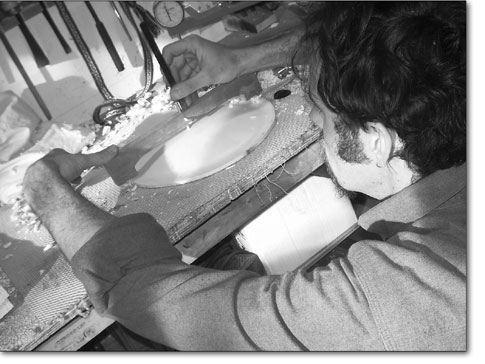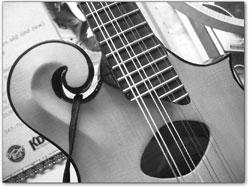|
| ||||
| Working some mandolin magic SideStory: Meltdown celebrates 12 years: Kicking off spring with
by Jaime Becktel Here’s a new word – luthier – one who makes or repairs stringed instruments. It’s also the newly acquired tag of Durangoan and mandolin builder Brian Locke, who with humble reluctance accepts the title previously reserved for master mando builders like John Monteleone and Lloyd Loar. As modest as they come, Locke’s smile mirrors the luster of inlaid shell adorning the blonde-wood of his Moonrise Mandolins. And after only three years of playing and making instruments, he is already carving out a place for himself alongside his heroes. Prior to his current incarnation as Luthier, Locke worked seasonally for the Forest Service on wilderness trail crews before deciding to try his hand with a mandolin-building kit. His first piece was shaky, but it sparked a romance for the craftsmanship of handmade instruments, and he’s been hooked ever since. Adept at working with his hands, whether fixing Volkswagen Beetles or wielding an ax in the backcountry, his transition to instrument building was a natural slide. He found in the mandolin a perfect synthesis of all his favorite things and an ultimate expression of the love he holds for art and music. “What turns me on about creating instruments is that the process incorporates all the artistic elements I love,” Locke says. “When I’m building, I’m using a lot of my senses. Touch is huge, feeling the tops and testing the flexibility. At first I was caught up in the technical side of the process, but then I started listening to subtle resonances, feeling the contours of the wood and using my fingers as built-in calipers. There’s something so satisfying in using the senses rather than some mechanical tool. It really brings you into your work and infuses your essence into the finished product.” The other striking element in the story of Locke’s brief, self-apprenticeship in mandolin building is his newly acquired musical talent. At age 27, with no prior training, he decided to give the mandolin a go and is now happily jamming away with his band of friends, who go by the name “Carute Roma” (Romani for “Gypsy Wagon”). This upbeat troupe of bohemian musicians has been heard all over Durango, performing its Gypsy tunes at weddings, festivals, benefits and coffee houses. “The
history of Gypsy music stems from the fact that people didn’t have money to buy instruments, so just about anything became fair game,” Locke says. “People just wanted to make music, they didn’t care what they were using.” Italy is credited as the birthplace of the traditional Neapolitan mandolin, and at the turn of the century, it was one of Europe’s most popular instruments. It spilled over to the New World in the form of mandolin orchestras and later, the bluegrass movement. The three traditional styles of mandolin music are Celtic, Brazilian and Italian, but over the years, it has been incorporated into a highly eclectic montage of musical shades woven from the American South to the Balkan Sea. Immortalized in the United States by the father of bluegrass, Bill Monroe, and classical master David Grisman, the mandolin is furiously plucked. It has been noted by many that the mandolin, like other stringed instruments, is inherently sexy by design. Sleek and curvaceous, you can’t help but admire its perfect symmetry. When you hold a Moonrise Mandolin in your hands, light flaring out from the striated maple wood, you behold some serious beauty. Start rapping with Locke about his feelings on contemporary American society, and he gets downright fired up. For him, building mandolins with great craftsmanship and love is his way of taking things back to a time before mass consumerism and the hypnotic contentedness of status-quo. “One of the issues I have with our society is our obsession with throwaway goods,” he says. “We don’t place much value on handmade creations anymore. That Old World value has kind of died out, and we now suffer from this plastic crap mentality that spills over into more than how we view our material goods, but also how we view ourselves.” Among other things, Locke is a revivalist, hoping to bring hand-built, tailor-made instruments back on the music scene at a price people can afford. The classic F-series mandos cranked out in hordes by big names like Gibson, Callings and Webber have met their match in the classy individuality of Locke’s Moonrise Mandolins. “The thing about homemade instruments is that they’re going to last and be passed down,” Locke says. “There’s a whole breed out there that are mass-produced on assembly lines without hardly any human touch, and I think it shows. When building an instrument, I try to keep in mind what it’s specifically going to be used for and what type of music it’s going to be playing.” Although primarily self-taught, Locke attended a gathering of mandolin masters last fall in Santa Cruz, Calif., where he picked the brain of legendary musician David Grisman and bowed down to craftmaster John Monteleon. “Monteleon was very inspiring to me because he approaches his mandolins as artistic creations that are not only functional entities, but are also individual works of art.” The youngest attendee by 20 years, Locke walked away from the symposium swollen with new knowledge and immense respect for the pioneers of mandolin music. He frequently haunts the halls of Canyon Music Woodworks, caressing the contours of antique mandolins, listening to their secrets of style and symmetry through the receptive instruments of his fingers. Next month, Locke heads off on a self-prescribed sabbatical to Northern California where he hopes to delve into the perfection of building techniques and design experimentation. “I’m just following my bliss at this point, seeing where it takes me. I still have a lot to learn, but that’s what keeps me going. Ultimately, when you find something you’re passionate about, why wait?”
|
In this week's issue...
- May 15, 2025
- End of the trail
Despite tariff pause, Colorado bike company can’t hang on through supply chain chaos
- May 8, 2025
- Shared pain
Dismal trend highlights need to cut usage in Upper Basin, too
- April 24, 2025
- A tale of two bills
Nuclear gets all the hype, but optimizing infrastructure will have bigger impact



